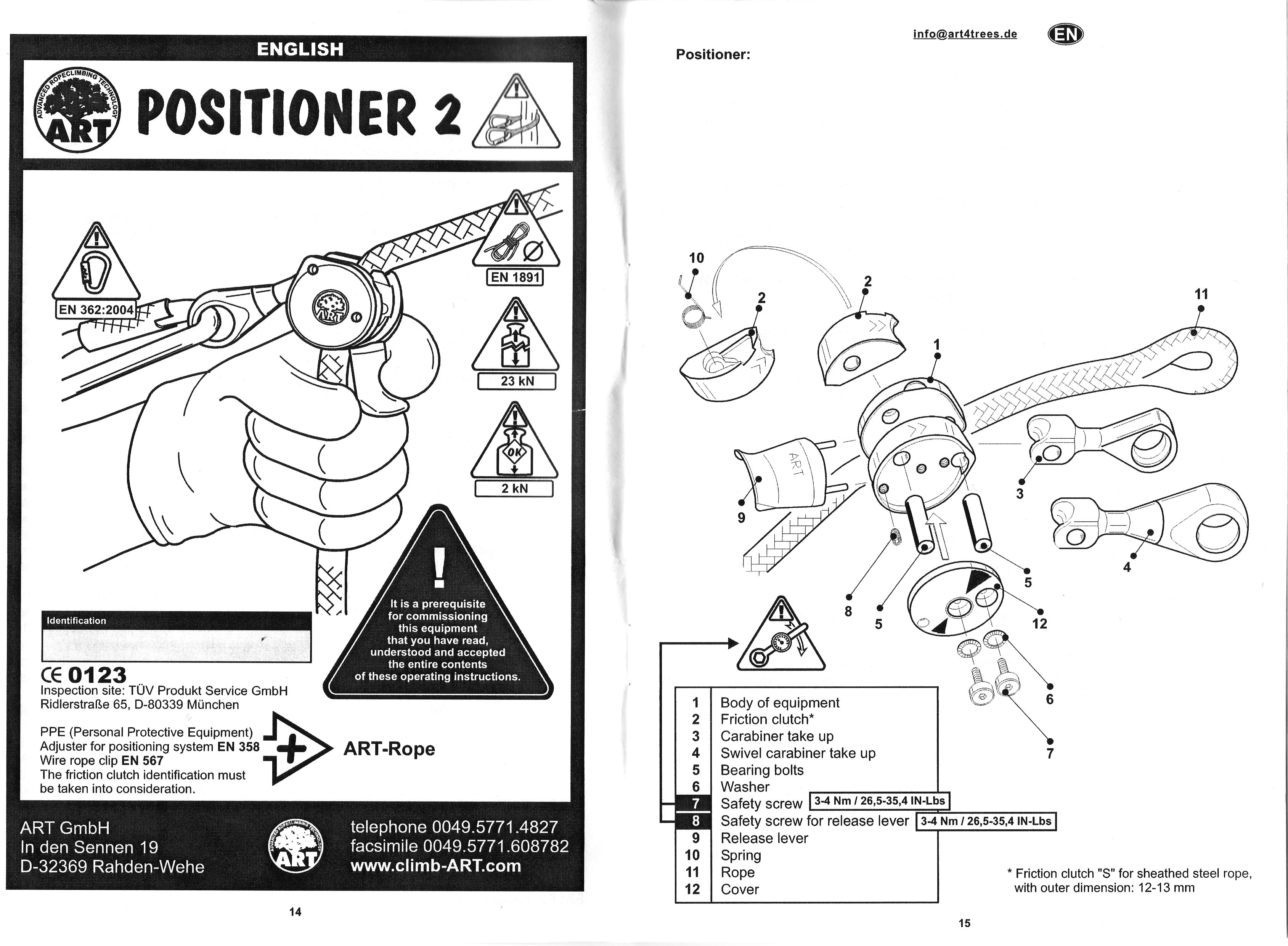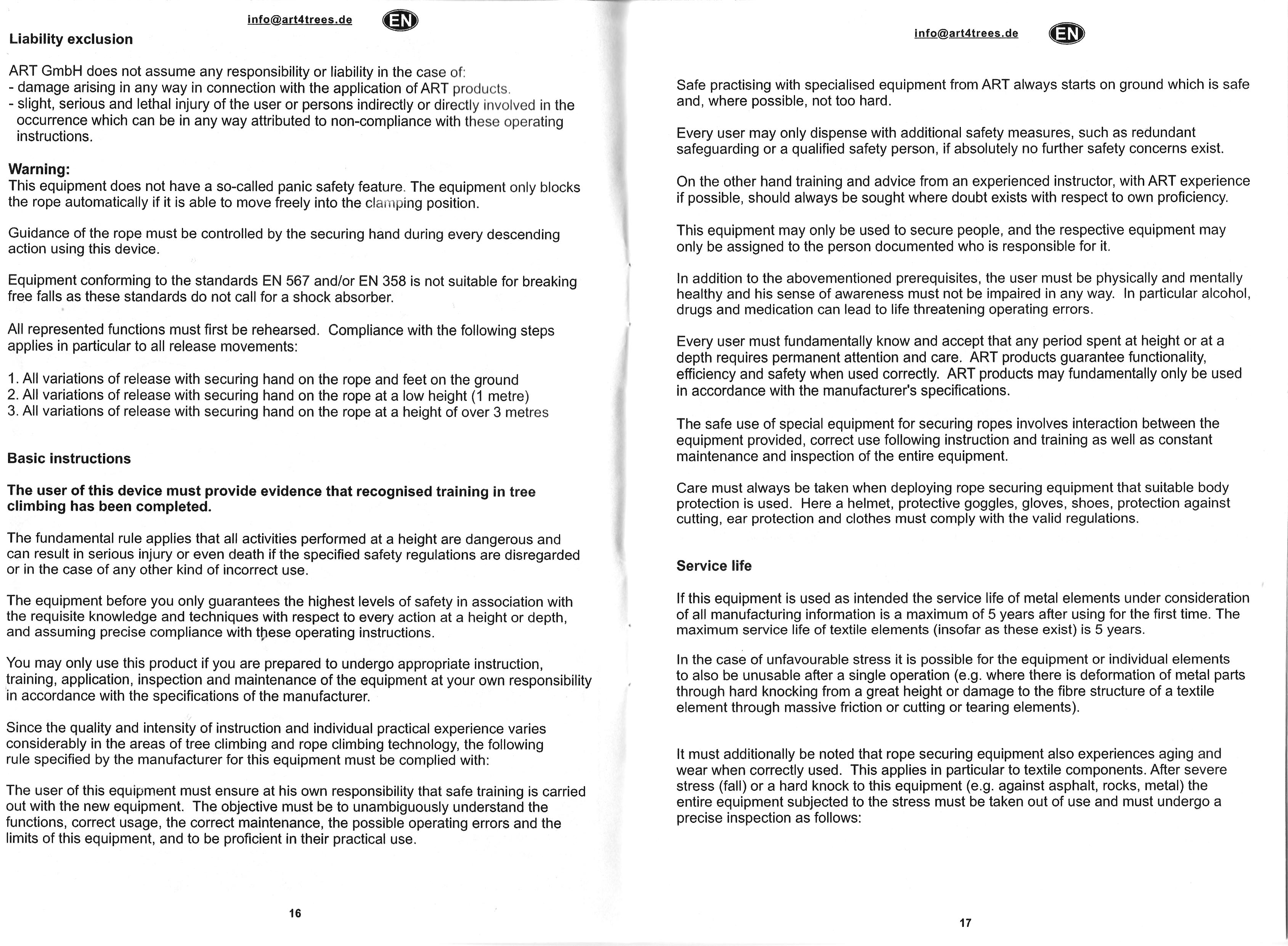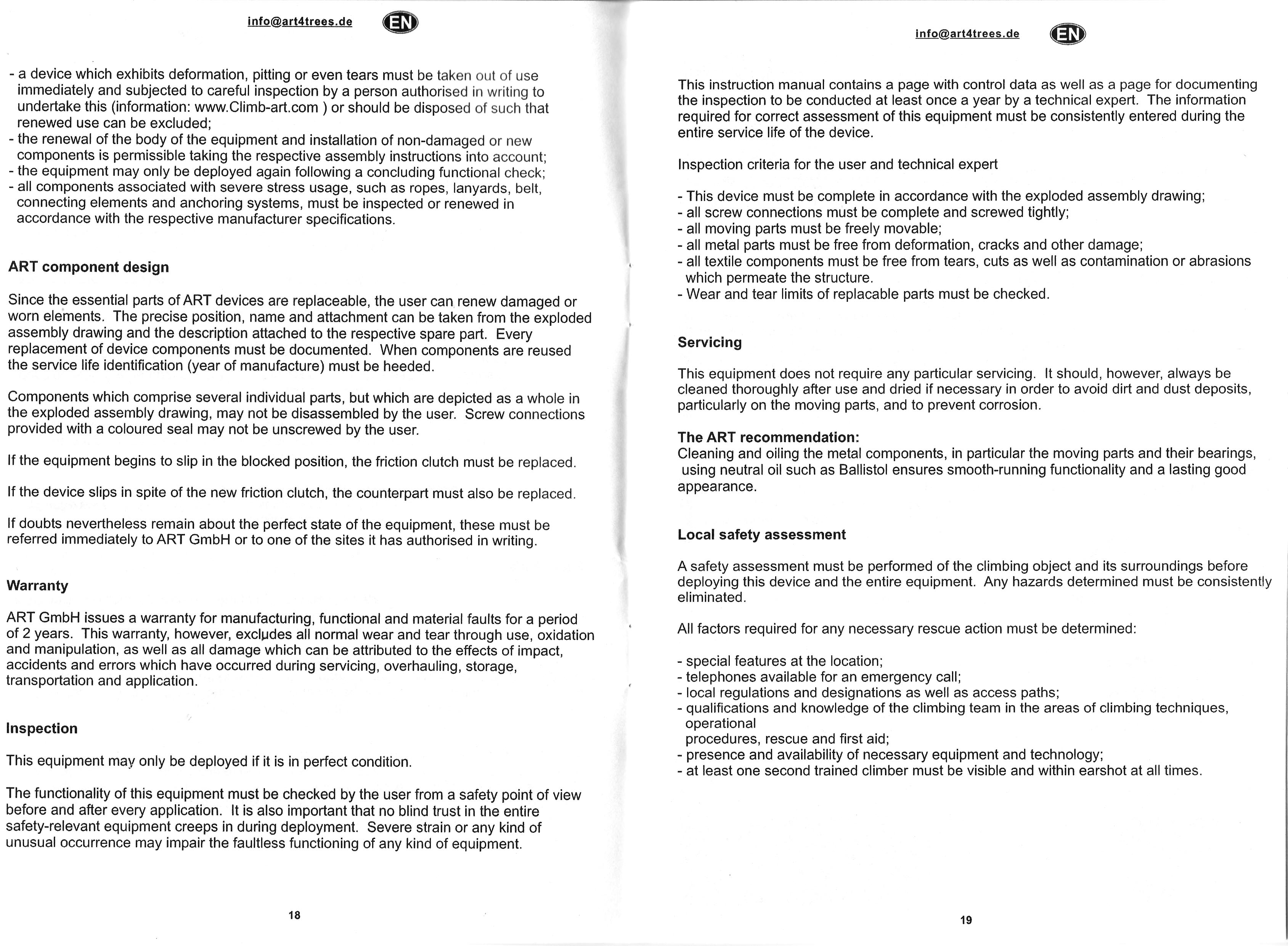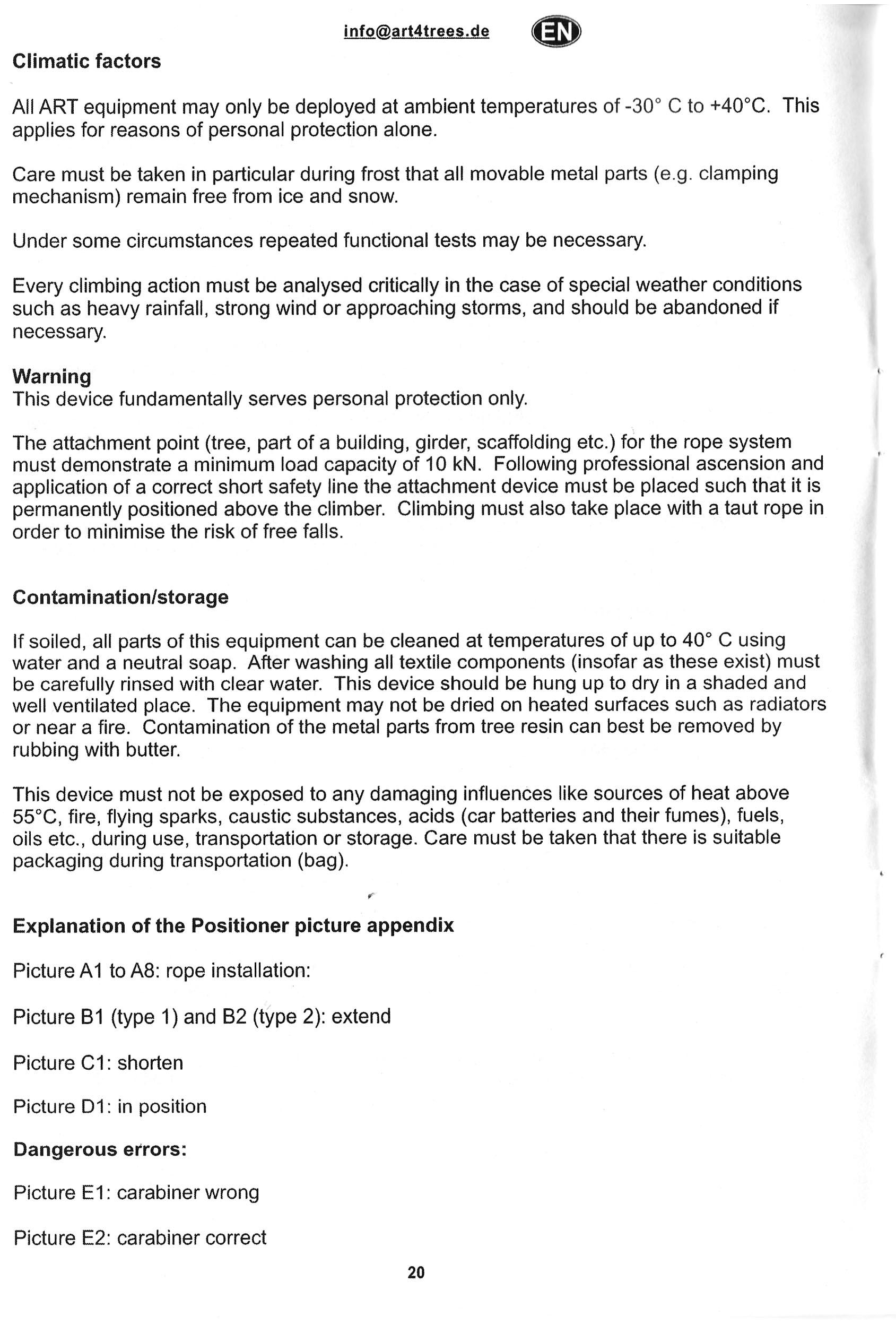Overview
[ Top
| Version B
| Positioner 2
| Return Flipline Adjusters
]
Version A
(#2666)
Technical Details
I acquired my Advanced Ropeclimbing Technology Positioner, Version A in 2017 as part of Bob Thrun’s collection.
My Advanced Ropeclimbing Technology Positioner, Version A is 56 mm. long, 83 mm. wide, 34 mm. high, and weighs 149 g.
The body is a teardrop-shaped cylinder with a large central slot that nearly bisects the block. The circular diameter is 45 mm., and the teardrop extension on one end increases the length to 51 mm. The block is 30 mm. thick. An inverted-U-shaped 3 mm. stainless steel rod is pressed into two holes in the top of the body. The friction clutch and carabiner attachment arm pivot in the central slot.
The friction clutch is a chordal segment of a circular disk, cut
away on the flat side and the top corner with a concave surface
to match the rope diameter. It pivots on a hex cap shoulder pin that passes through from one side. A button-head hex screw and washer keep this pin from backing out. A button-head allen screw and washer is screwed into the upper outside of the friction clutch. Two 19 mm. o-rings twisted and looped around this screw and the U-shaped rod act to close the clutch against the rope. A second button-head hex screw limits how far the clutch can open.
The carabiner arm is 58 mm. long and 9 mm. thick along
most of its length, widening at the base to fit the slot. It pivots on another hex cap shoulder pin that passes through from one side. Another button-head hex screw and washer keep this pin from backing out. There
is a small oil hole in the base of the arm that passes down to the
pivot. The carabiner eye is 15 mm. in diameter.
There are no markings on the positioner other than a sticker. The sticker is printed with "ADVANCED ROPECLIMBING TECHNOLOGY," the ART Tree logo, "POSITIONER inside an ellipse, "MADE IN GERMANY," "HUBERT KOWALEWSKI," and "CE -299."
This Positioner is nicely made, but using an o-ring instead of a spring to close the clutch is, in my opinion, a cheap, crude choice. I much prefer the spring used on Version B. At least there was a pair of spare o-rings included with this Positioner.
[ Top
| Version B
| Positioner 2
| Return Flipline Adjusters
]
Version B
(#2667)
Technical Details
I acquired my Advanced Ropeclimbing Technology Positioner, Version B in 2017 as part of Bob Thrun’s collection.
My Advanced Ropeclimbing Technology Positioner, Version B is 57 mm. long, 90 mm. wide, 34 mm. high, and weighs 155 g.
The body is a teardrop-shaped cylinder with a large central slot that nearly bisects the block. The circular diameter is 45 mm., and the teardrop extension on one end increases the length to 51 mm. The block is 31 mm. thick. The friction clutch and carabiner attachment arm pivot in the central slot. The friction clutch is a chordal segment of a circular disk, cut
away on the flat side and the top corner with a concave surface
to match the rope diameter. It pivots on a pin that passes through from one side. Two button-head hex screws and washers keep this pin from backing out. A coil spring sits in a recess in the side of the clutch. A button-head hex screw screwed into the outside of the friction clutch limits how far the clutch can open.
The release lever is 31 mm. long, tapered, and has a U-shaped cross section. It is pinned to the main block, and a set screw secures one of the pins.
The carabiner arm is 58 mm. long and 10 mm. thick along
most of its length, widening at the base to fit the slot. It pivots on another pin that passes through from one side. Two more button-head hex screws and washers keep this pin from backing out. There
is a small oil hole in the base of the arm that passes down to the
pivot. The carabiner eye is 15 mm. in diameter.
The body of the Positioner is marked with "Positioner," a book-with-an-"i" icon, the ART tree logo, "EN358," "EN567," "CE0123, and "0601 168" on the front, and with two stacked inverted "V"s on the circumference, pointing toward the carabiner attachment arm. The release lever is marked with the ART tree logo. The carabiner attachment arm is marked "ART" on one side and "P 06" on the other. The clutch block is marked with two stacked inverted "V"s pointing toward the carabiner attachment arm. All of these markings are in dot-matrix form.
This positioner is very well made. The new release lever (replacing the U-shaped rod) and clutch spring (replacing the O-rings) are definite improvements.
[ Top
| Version A
| Version B
| Return Flipline Adjusters
]
Positioner 2
(#1656)
Technical Details
I acquired my Advanced Ropeclimbing Technology Positioner 2 from WesSpur Tree Equipment in 2009.
The Positioner 2 is a flipline adjuster. It is 88 mm. tall, 56 mm. wide, and 35 mm. thick, and weighs 154 g. It consists of an aircraft aluminum body with a spring-loaded friction clutch, a carabiner attachment arm, and a release lever.
The body is a teardrop-shaped cylinder with a large central slot that nearly bisects the block. The circular diameter is 45 mm., and the teardrop extension on one end increases the length to 51 mm. The block is 31 mm. thick. The friction clutch and carabiner attachment arm pivot in the central slot. The friction clutch is a chordal segment of a circular disk, cut
away on the flat side and the top corner with a concave surface
to match the rope diameter. It pivots on a pin that passes through from one side. A coil spring sits in a recess in the side of the clutch. The carabiner arm is 60 mm. long and 10 mm. thick along
most of its length, widening at the base to fit the slot. There
is a small oil hole in the base of the arm that passes down to the
pivot. The carabiner eye is 15 mm. in diameter.
The release lever is 31 mm. long, tapered, and has a U-shaped cross section. It is pinned to the main block, and a set screw secures one of the pins.
A plastic cover on on one side of the body holds the various pivot pins in place. There is a double-faced velcro™ strip screwed to the other side.
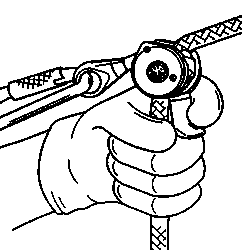 The body of the Positioner 2 is marked with "Positioner," a book-with-an-"i" icon, the ART tree logo, "EN358," "EN567," "CE0123, and "0901 228" on the front. The friction clutch has with two stacked inverted "V"s on the circumference, pointing toward the carabiner attachment arm. The release lever is marked "ART." The carabiner attachment arm is marked "ART" on one side and "P 09" on the other. The clutch block is marked with two stacked inverted "V"s pointing toward the carabiner attachment arm, "Ø11-13" and "KB.POS." All of these markings are in dot-matrix form. The machine screws holding the cover on have "8.8" and "UM" marked on their heads.
The body of the Positioner 2 is marked with "Positioner," a book-with-an-"i" icon, the ART tree logo, "EN358," "EN567," "CE0123, and "0901 228" on the front. The friction clutch has with two stacked inverted "V"s on the circumference, pointing toward the carabiner attachment arm. The release lever is marked "ART." The carabiner attachment arm is marked "ART" on one side and "P 09" on the other. The clutch block is marked with two stacked inverted "V"s pointing toward the carabiner attachment arm, "Ø11-13" and "KB.POS." All of these markings are in dot-matrix form. The machine screws holding the cover on have "8.8" and "UM" marked on their heads.
The Positioner 2 looks very much like the SpiderJack, minus the wooden block. The Positioner 2 is very well made. Mine came with a 55-page manual, with instructions in five languages and additional notes in eleven more. Illustrations in the manual show how to use, disassemble, and repair the device (the positioner even came with two Allen wrenches). Overall, I think it is a very good manual, despite the author’s inability to resist following the European practice of using incomprehensible icons as a substitute for effective communication. At least they provided a legend!
[ Top
| Version A
| Version B
| Positioner 2
]



 The body of the Positioner 2 is marked with "Positioner," a book-with-an-"i" icon, the ART tree logo, "EN358," "
The body of the Positioner 2 is marked with "Positioner," a book-with-an-"i" icon, the ART tree logo, "EN358," "